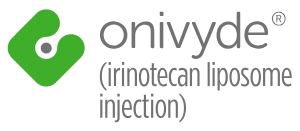INDICATION AND IMPORTANT SAFETY INFORMATION
INDICATION
ONIVYDE® (irinotecan liposome injection) is indicated, in combination with fluorouracil (5-FU) and leucovorin (LV), for the treatment of patients with metastatic adenocarcinoma of the pancreas after disease progression following gemcitabine-based therapy.
Limitation of Use: ONIVYDE is not indicated as a single agent for the treatment of patients with metastatic adenocarcinoma of the pancreas.
CONTRAINDICATION
- ONIVYDE is contraindicated in patients who have experienced a severe hypersensitivity reaction to ONIVYDE or irinotecan HCl
WARNINGS AND PRECAUTIONS
- Severe Neutropenia: See Boxed WARNING. In patients receiving ONIVYDE/5-FU/LV, the incidence of Grade 3/4 neutropenia was higher among Asian (18/33 [55%]) vs White patients (13/73 [18%]). Neutropenic fever/neutropenic sepsis was reported in 6% of Asian vs 1% of White patients
- Severe Diarrhea: See Boxed WARNING. Severe and life-threatening late-onset (onset >24 hours after chemotherapy [9%]) and early-onset diarrhea (onset ≤24 hours after chemotherapy [3%], sometimes with other symptoms of cholinergic reaction) were observed
- Interstitial Lung Disease (ILD): Irinotecan HCl can cause severe and fatal ILD. Withhold ONIVYDE in patients with new or progressive dyspnea, cough, and fever, pending diagnostic evaluation. Discontinue ONIVYDE in patients with a confirmed diagnosis of ILD
- Severe Hypersensitivity Reactions: Irinotecan HCl can cause severe hypersensitivity reactions, including anaphylactic reactions. Permanently discontinue ONIVYDE in patients who experience a severe hypersensitivity reaction
- Embryo-Fetal Toxicity: ONIVYDE can cause fetal harm when administered to a pregnant woman. Advise females of reproductive potential to use effective contraception during and for 1 month after ONIVYDE treatment
ADVERSE REACTIONS
- The most common adverse reactions (≥20%) were diarrhea (59%), fatigue/asthenia (56%), vomiting (52%), nausea (51%), decreased appetite (44%), stomatitis (32%), and pyrexia (23%)
- The most common Grade 3/4 adverse reactions (≥10%) were diarrhea (13%), fatigue/asthenia (21%), and vomiting (11%)
- Adverse reactions led to permanent discontinuation of ONIVYDE in 11% of patients receiving ONIVYDE/5-FU/LV; The most frequent adverse reactions resulting in discontinuation of ONIVYDE were diarrhea, vomiting, and sepsis
- Dose reductions of ONIVYDE for adverse reactions occurred in 33% of patients receiving ONIVYDE/5-FU/LV; the most frequent adverse reactions requiring dose reductions were neutropenia, diarrhea, nausea, and anemia
- ONIVYDE was withheld or delayed for adverse reactions in 62% of patients receiving ONIVYDE/5-FU/LV; the most frequent adverse reactions requiring interruption or delays were neutropenia, diarrhea, fatigue, vomiting, and thrombocytopenia
- The most common laboratory abnormalities (≥20%) were anemia (97%), lymphopenia (81%), neutropenia (52%), increased ALT (51%), hypoalbuminemia (43%), thrombocytopenia (41%), hypomagnesemia (35%), hypokalemia (32%), hypocalcemia (32%), hypophosphatemia (29%), and hyponatremia (27%)
DRUG INTERACTIONS
- Avoid the use of strong CYP3A4 inducers, if possible, and substitute non-enzyme inducing therapies ≥2 weeks prior to initiation of ONIVYDE
- Avoid the use of strong CYP3A4 or UGT1A1 inhibitors, if possible, and discontinue strong CYP3A4 inhibitors ≥1 week prior to starting therapy
USE IN SPECIFIC POPULATIONS
- Pregnancy and Reproductive Potential: See WARNINGS & PRECAUTIONS. Advise males with female partners of reproductive potential to use condoms during and for 4 months after ONIVYDE treatment
- Lactation: Advise nursing women not to breastfeed during and for 1 month after ONIVYDE treatment
References: 1. ONIVYDE [package insert]. Basking Ridge, NJ. Ipsen Biopharmaceuticals, Inc.; 2017. 2. Ipsen data on file: IQVIA medical claims post-gemcitabine usage analysis, June 2018-May 2019. 3. Ipsen data on file. 4. Referenced with permission from the NCCN Clinical Practice Guidelines in Oncology (NCCN Guidelines®) for Pancreatic Adenocarcinoma V.2.2021. © National Comprehensive Cancer Network, Inc. 2021. All rights reserved. Accessed July 12, 2021. To view the most recent and complete version of the guideline, go online to NCCN.org. 5. Sohal DPS, Kennedy EB, Khorana A, et al. Metastatic Pancreatic Cancer ASCO Clinical Practice Guideline Update. J Clin Oncol. 2018;36(24):2545-2556. 6. Deeb A, Haque S-U, Olowokure O. Pulmonary metastases in pancreatic cancer, is there a survival influence? J Gastrointest Oncol. 2015;6(3):E48-E51. 7. Data on file #1. Basking Ridge, NJ. Ipsen Biopharmaceuticals, Inc.; 2015. 8. Wang-Gillam A, Li C-P, Bodoky G, et al. Nanoliposomal irinotecan with fluorouracil and folinic acid in metastatic pancreatic cancer after previous gemcitabine-based therapy (NAPOLI-1): a global, randomised, open-label, phase 3 trial. Lancet. 2016;387:545-557. 9. Zhang H. Onivyde for the therapy of multiple solid tumors. OncoTargets Ther. 2016;9:3001-3007. 10. Locker GY, Hamilton S, Harris J, et al. ASCO 2006 update of recommendations for the use of tumor markers in gastrointestinal cancer. J Clin Oncol. 2006;24(33):5313-5327. 11. Columbia University Irving Medical Center. The Pancreas Center. Lab tests. https://columbiasurgery.org/pancreas/lab-tests. Accessed January 29, 2020. 12. NIH. National Cancer Institute. Pancreatic cancer treatment (adult) (PDQ®)-health professional version. https://www.cancer.gov/types/pancreatic/hp/pancreatic-treatment-pdq. Accessed November 27, 2019. 13. Ducreux M, Cuhna AS, Caramella C, et al; on behalf of ESMO Guidelines Committee. Cancer of the pancreas: ESMO Clinical Practice Guidelines for diagnosis, treatment and follow-up. Ann Oncol. 2015;26(suppl 5):v56-v68. 14. Wang-Gillam A, Huber RA, Siveke JT, et al. NAPOLI-1 phase 3 study of liposomal irinotecan in metastatic pancreatic cancer: Final overall survival analysis and characteristics of long-term survivors. Eur J Cancer. 2019;108:78-87. 15. Data on file #3. Basking Ridge, NJ. Ipsen Biopharmaceuticals, Inc.; 2015.



